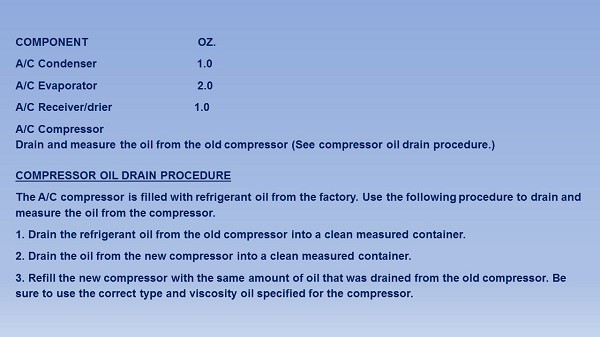OEM oil capacity information
By Richard Hawkins, MACS contributor
In my previous blog article, we covered how OEM oil capacity information provided by the various information sources can create confusion. Please see the picture below.

A chart from the previous blog article.
Unfortunately, it can get worse, so we will look at a couple of other examples.
Example #1. When clicking on “Refrigerant Oil” in the website of an information source, the only capacity information that comes up is as follows: “Standard: Oil capacity inside new compressor [120 + 15 cc (4.0 + 0.5 fl. oz.)] – Remaining oil amount in removed compressor assembly = Oil amount to be removed before installation.” That is the only information about oil capacity which is provided for this vehicle.
Remember this information came from the OEM in their service information. They are stating that their replacement compressor for this vehicle contains [120 + 15 cc (4.0 + 0.5 fl. oz.)]. It is interesting that they used ” 120 + 15 cc” and 4.0 + 0.5 fl. oz.” It would have been simpler if they had just said 135 cc or 4.5 oz.
If you are installing an OEM replacement compressor in this example then it “should” contain 4.5 ounces of oil but if the compressor is not drained and the oil measured, the amount will not be known for sure. Also, if an aftermarket compressor is being installed, there is no standard that exists in the industry regarding the amount of oil that might be shipped in a replacement compressor. It might have no oil in it, a partial charge, or a full charge or even more than a full charge. To make matters worse, the OEM does not provide the total system capacity for this vehicle.
What might occur if someone took this information and just “ran with it” without considering what had been done with other parts of the system (drier replacement, condenser replacement, flushing, etc.) We will use the same example which was used in the last blog article except for this vehicle having a slightly smaller refrigerant capacity.
- The vehicle has suffered a catastrophic compressor failure and compressor replacement is necessary.
- It is a single expansion valve system and has a 19.40-ounce refrigerant capacity.
- The condenser which contains a drier is being replaced.
- The remainder of the system is being flushed.
- As a result, the system is dry, and the total system oil capacity needs to be installed in the compressor.
Let’s say the replacement compressor contains 4.5 ounces of oil. The compressor which was removed from the vehicle is drained and the oil measured, and it contains 2.25 ounces of oil. The technician drains 2.25 ounces from the replacement compressor. That is going to leave 2.25 ounces in the compressor and that is the amount that will be in the system. 2.25 ounces might be enough oil for a system which uses a compressor with an oil separator (which retains most of the oil in the compressor) and has a 12-ounce refrigerant capacity.
However, this vehicle uses a compressor without an oil separator and has 19.40 oz, refrigerant capacity. As stated earlier, unfortunately the OEM does not provide the total system oil capacity. However, we know from dealing with similar systems where the oil capacity is provided that 2.25 ounces is not anywhere close to being enough.
A system like this would be expected to have a total system oil capacity in the range of about 4.5 to 5.0 ounces. If that compressor is installed and the system contains only 2.25 ounces of oil then the result will be a very short life for the compressor and a catastrophic failure. Experienced technicians will recognize there is a potential problem with this information. However, I can tell you from personal experience on a tech line that a lot of inexperienced technicians have made this mistake.
Example #2. When clicking on “Refrigerant Oil” the only thing that comes up is: “ND 8 or equivalent”. There is nothing there at all regarding capacities. It is amazing that an OEM would not provide the system oil capacity for an A/C system but it does occur with some regularity. Compared to example #1, it might actually be better as it would force an inexperienced technician to do some research instead of experiencing the results outlined.
When it comes to A/C systems and oil capacity information, caution must be observed.
Join MACS as a member to stay aware of important technical information.
Leave a Reply